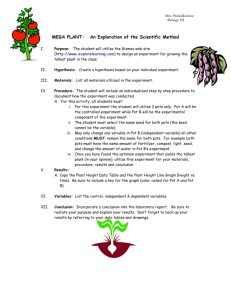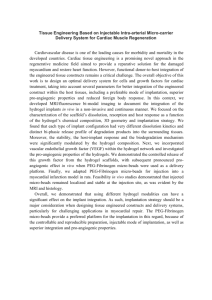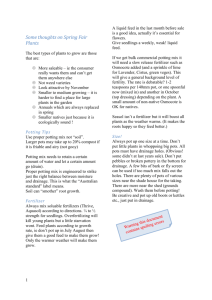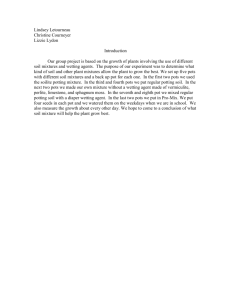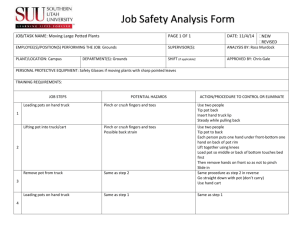Effect of a Medium-Incorporated Hydrogel on Plant Growth and
advertisement
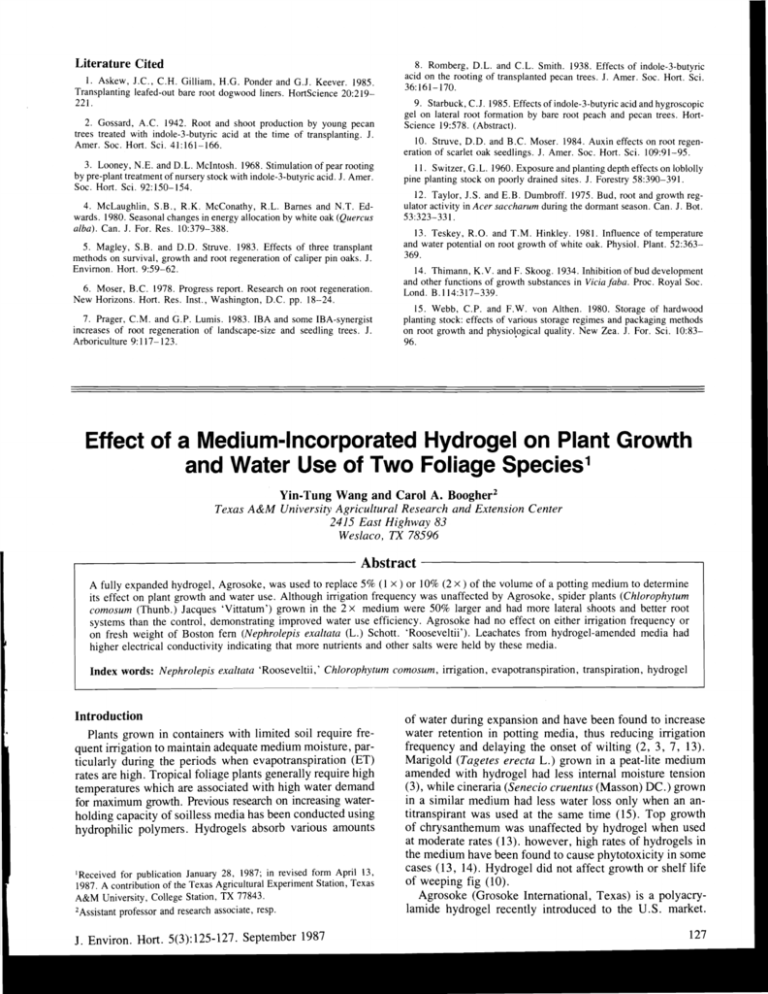
Literature Cited 1. Askew, J.C., C.H. Gilliam, H.G. Ponder and G.J. Keever. 1985. Transplanting leafed-out bare root dogwood liners. HortScience 20:219­ 221. 2. Gossard, A.C. 1942. Root and shoot production by young pecan trees treated with indole-3-butyric acid at the time of transplanting. J. Amer. Soc. Hort. Sci. 41:161-166. 3. Looney, N.E. and D.L. McIntosh. 1968. Stimulation of pear rooting by pre-plant treatment of nursery stock with indole-3-butyric acid. J. Amer. Soc. Hort. Sci. 92: 150-154. 4. McLaughlin, S.B., R.K. McConathy, R.L. Barnes and N.T. Ed­ wards. 1980. Seasonal changes in energy allocation by white oak (Quercus alba). Can. J. For. Res. 10:379-388. 5. Magley, S.B. and D.O. Struve. 1983. Effects of three transplant methods on survival, growth and root regeneration of caliper pin oaks. J. Envimon. Hort. 9:59-62. 6. Moser, B.C. 1978. Progress report. Research on root regeneration. New Horizons. Hort. Res. Inst., Washington, D.C. pp. 18-24. 7. Prager, C.M. and G.P. Lumis. 1983. IBA and some IBA-synergist increases of root regeneration of landscape-size and seedling trees. J. Arboriculture 9: 117-123. 8. Romberg, D.L. and C.L. Smith. 1938. Effects of indole-3-butyric acid on the rooting of transplanted pecan trees. J. Amer. Soc. Hort. Sci. 36: 161-170. 9. Starbuck, C.J. 1985. Effects of indole-3-butyric acid and hygroscopic gel on lateral root formation by bare root peach and pecan trees. Hort­ Science 19:578. (Abstract). 10. Struve, D.O. and B.C. Moser. 1984. Auxin effects on root regen­ eration of scarlet oak seedlings. J. Amer. Soc. Hort. Sci. 109:91-95. 11. Switzer, G.L. 1960. Exposure and planting depth effects on loblolly pine planting stock on poorly drained sites. J. Forestry 58:390-391. 12. Taylor, J.S. and E.B. Dumbroff. 1975. Bud, root and growth reg­ ulator activity in Acer saccharum during the dormant season. Can. J. Bot. 53:323-331. 13. Teskey, R.O. and T.M. Hinkley. 1981. Influence of temperature and water potential on root growth of white oak. Physiol. Plant. 52:363­ 369. 14. Thimann, K.V. and F. Skoog. 1934. Inhibition of bud development and other functions of growth substances in Viciafaba. Proc. Royal Soc. Lond. B.114:317-339. 15. Webb, C.P. and F.W. von Althen. 1980. Storage of hardwood planting stock: effects of various storage regimes and packaging methods on root growth and physiological quality. New Zea. J. For. Sci. 10:83­ 96. · Effect of a Medium-Incorporated Hydrogel on Plant Growth and Water Use of Two Foliage Species 1 Yin-Tung Wang and Carol A. Boogher 2 Texas A&M University Agricultural Research and Extension Center 2415 East Highway 83 Weslaco, TX 78596 . . . . . . - - - - - - - - - - - - - - - - - - Abstract - - - - - - - - - - - - - - - - - - - - , A fully expanded hydrogel, Agrosoke, was used to replace 5% (1 x) or 10% (2 X) of the volume of a potting medium to determine its effect on plant growth and water use. Although irrigation frequency was unaffected by Agrosoke, spider plants (Chlorophytum comosum (Thunb.) Jacques 'Vittatum') grown in the 2 x medium were 50% larger and had more lateral shoots and better root systems than the control, demonstrating improved water use efficiency. Agrosoke had no effect on either irrigation frequency or on fresh weight of Boston fern (Nephrolepis exaltata (L.) Schott. 'Rooseveltii'). Leachates from hydrogel-amended media had higher electrical conductivity indicating that more nutrients and other salts were held by these media. Index words: Nephrolepis exaltata 'Rooseveltii,' Chlorophytum comosum, irrigation, evapotranspiration, transpiration, hydrogel Introduction Plants grown in containers with limited soil require fre­ quent irrigation to maintain adequate medium moisture, par­ ticularly during the periods when evapotranspiration (ET) rates are high. Tropical foliage plants generally require high temperatures which are associated with high water demand for nlaxinlum growth. Previous research on increasing water­ holding capacity of soilless media has been conducted using hydrophilic polynlers. Hydrogels absorb various amounts lReceived for publication January 28, 1987; in revised form April 13, 1987. A contribution of the Texas Agricultural Experiment Station, Texas A&M University, College Station, TX 77843. 2 Assistant professor and research associate, resp. J. Environ. Hort. 5(3):125-127. September 1987 of water during expansion and have been found to increase water retention in potting media, thus reducing irrigation frequency and delaying the onset of wilting (2, 3, 7, 13). Marigold (Tagetes erecta L.) grown in a peat-lite medium amended with hydrogel had less internal moisture tension (3), while cineraria (Senecio cruentus (Masson) DC.) grown in a similar nledium had less water loss only when an an­ titranspirant was used at the same time (15). Top growth of chrysanthemum was unaffected by hydrogel when used at moderate rates (13). however, high rates of hydrogels in the medium have been found to cause phytotoxicity in some cases (13, 14). Hydrogel did not affect growth or shelf life of weeping fig (10). Agrosoke (Grosoke International, Texas) is a polyacry­ lamide hydrogel recently introduced to the U. S. market. 127 Water absorption in distilled water was below 40 g of water per g of dry material, in contrast to many other hydrogels capable of absorbing several hundred g of water per g of dry material. It is also recommended that Agrosoke be added to the medium in its fully expanded form for best results, whereas the other hydrogels are mixed directly into the medium. The objectives of this study were to deternline the effect of Agrosoke on plant growth during the summer production period and on water use by 2 foliage plant species. added to each pot so as to collect approximately 30 ml (1 oz) of leachate for EC and pH measurements. Pots were weighed 1 hI' after leachates were collected and weighed at the same time of day during the next several days (5 days for spider plant and 2 days for Boston fern) to determine water loss due to ET. Plants were irrigated immediately after completion of ET determinations. Fresh weight of the shoots and roots, and number of shoots per pot in spider plant and top fresh weight of Boston fern were recorded 2 days after irrigation. Materials and Methods Results and Discussion On June 6, 1986, 33 single-shoot liners each of spider plant and Boston fern 'Nere planted singly in 15 cm (6 in) containers in a mediunl of sphagnum peat moss and pine bark (equal parts by vol) amended with 6 kg/m 3 (10 Ib/yd 3 ) Nutricote (14N-6P-11.6K, type 180),2 kg (3.4 Ib/yd 3 ) Mi­ cromax, and 3 kg/m1 3 (5 Ib/yd 3 ) dolomite. Two hundred g (7 oz) of agrosoke was placed in 8 1 (2 gal) of water for 16 hI' to reach full expansion. Treatments included replacing 5% (1 x , the recommended rate) and 10% (2 x , twice the recommended rate) of the base medium volume with the fully expanded gel, which was thoroughly mixed into the medium. Initial pot weights were 550,615, and 680 g (1.21, 1.35, and 1.50 Ib) for the control, 1 x, and 2 x media, respectively. Pots were thoroughly watered immediately after planting and placed on benches in a shade house covered with one layer each of black polypropylene shade fabric and poly­ ethylene plastic (6 mil) providing 520 umol.s -1 m -2 (ap­ proximately 3600 ft-c) rnaximum photosynthetic photon flux (PPF). A white paint 'was applied to the polyethylene on July 17, reducing maximum PPF to 280 umol.s- Im- 2 • Temperatures in the production house ranged from 24° to 40°C (75° to 104°F). Pots were checked daily and water with an electrical conductivity (EC) of 1.35 to 1.50 mS cm -I (approximately 950 to 1050 ppm total salts) was used to irrigate plants as needed. Number of irrigations was recorded for each pot. Water containing 200 mg I-I (200 ppm) N from a 20N­ 8.6P-16.6K fertilizer (20-20-20, W.R. Grace & Co.) was used for all irrigations after August 22. There was a single plant in each pot as an experimental unit replicated 11 times in a randomized complete block design. On September 22, all plants and root systenls of spider plants were evaluated for visual quality using a scale of 1 to 5 (see Table 1), and pots were thoroughly watered at 1600 HR. At 0830 HFt the following morning, water was Spider plant. Visual grade of the spider plants was sub­ stantially better in the 2 x treatment due to the 50% larger canopy and greater nunlber of lateral shoots (Table 1). How­ ever, Agrosoke at the recommended rate (1 x ) did not pro­ mote plant growth. Distribution of plant fresh weight between the shoots and root systems (shootroot ratio) was unaffected by Agrosoke. Root systems of the 2 x plants were also 50% larger (Table 1) and occupied a larger volume of the me­ dium, providing a better means of water and nutrient uptake. Since plants were given only plain water during most of the experimental period, nutrients in the media were likely at suboptimal levels (Table 2) before supplemental fertil­ ization was initiated. Increased growth in the 2 x plants may have been the result of improved nutrient levels in the medium. Previous studies have shown that incorporation of hydrogel in a potting medium increased its ability to retain nutrients for plant use (5) and enhanced the growth of Li­ gustrum lucidum 'Compactum' at low fertility levels (14). High initial ET rates declined as the amount of available water in the media decreased (Table 3), which agrees with other research (1), since the day-to-day climate remained fairly constant. An analysis of pot weights revealed that pots amended with Agrosoke at both rates were 40 g (1.4 oz) heavier than the control (Table 1). This amount of extra water was a very small fraction of the total water held by the base medium in a 15 cm (6 in) pot. It is not clear why the 2 x pots retained the same amount of extra water as the' 1 x pots. Although, it may be possible that Agrosoke in the 2 x nledium deteriorated faster due to the higher salt level in this medium (Table 2). The higher initial ET rates observed in the 2 x plants were not proportional to their increased size (Table 3). Incor~ poration of Agrosoke into the potting medium did not affect evaporational water loss from the medium surface without foliage coverage. Consequently, either leaf transpiration rate in the 2 x plants was substantially lower than the others, Table 1. Effect of Agrosoke hydrogel on growth, pot weight and irrigation of spider plants. Plant fresh wt (g) Plant Agrosoke rate gradt~ Control Ix 2x 2.6 z b Y 2.7 b 4.1 a Root quality Shoot 2.9 xb 2.8 b 3.6 a 110 b 117 b 161 a Pot weight (g) Root Shoot:root ratio With plant Without plant No. of irrigations No of lateral shoots 36 b 39 b 56 a 3.05 a 3.00 a 2.88 a 1269 c 1318 b 1381 a 1123 b 1162 a 1164 a 21.8 ab 20.5 b 23.5 a 5.0 a 5.6 ab 6.4 b ZBased on a scale of 1 to 5, where 1 = unsalable, 3 = good, and 5 = excellent. YMeans within a column followed by the same letter or letters are not significant at the 5% level as measured by Duncan's new multiple range test. xBased on a scale of I to 5, where I = less than 5 roots at the bottom of the soil mass, 3 = abundant roots, and 5 = bottom of the soil mass covered by roots. 128 J. Environ. Hort. 5(3): 127-130. September 1987 Table 2. Initial and final electrical conductance and pH of medium leachates as affected by Agrosoke hydrogel in the medium. Final Initial Agrosoke rate Electrical conductance (mS m -1) 092 CZ 106 b 125 a Control Ix 2x Spider Plant pH Electrical conductance (mS m -1) 663 a 645 b 650 b 304 b 412 a 412 a Boston fern pH Electrical conductance (mS m- 1 ) pH 501 a 500 a 511 a 331 b 379 a 411 a 528 a 513 a 495 b ZMeans within a colunln followed by the same letter or letters are not significant at the 5% level as measured by Duncan's new multiple range test. or water evaporation rate in the 2 x pots was reduced due to greater coverage of the medium surface by the foliage. In either case, water had been used more efficiently by the 2 x plants because these larger, faster growing plants had similar requirements as controls. Other studies (3, 15) did not find hydrogels to improve water use efficiency, possibly due to the small pot size (10 cml4 in) and high transpiration rates of those plants being studied. Pine bark used in this study may have reduced evaporational and transpirational water loss (1) compared to the peat-lite media used in other studies. Boston fern. Agrosoke had no significant effect on the fresh weight or visual grade of Boston fern, although the control plants tended to have greater fresh weights (Table 4). Irrigation frequency increased proportionally with greater fresh weight, which may have been a function of higher transpiration rates due to the greater total leaf area. It was reported previously that the leaf area of Boston fern varied even when there was no significant difference in dry weights (9). Because of the extremely high ET rates in Boston ferns, Table 3. the limited additional water in 2 x pots did not reduce ir­ rigation frequency (Tables 3 and 4). Addition of Agrosoke to the medium increased the initial EC of leachates, with the highest EC in the 2 x treatment (Table 2). Because of the constant fertilization near the end of this experiment, final Ee of both plant species was high. Since more soluble salts are held in the media containing the hydrogel (5), fertilization rate or frequency would be reduced to avoid any possible damage to plants which are sensitive to high salt level in the medium. Initial leachate pH was decreased by the hydrogel, probably due to i~s release of free acids to the medium (14). The lower final leachate pH was likely a result of constant fertilization to­ ward the end of the production period (11, 12). Although the final pH was lower than that for the optimum growth of most foliage plants, it was within the range for optimum growth of Boston fern (4). In this experiment, fully expanded Agrosoke was mixed into a medium to replace given portions (5% and 10%) of the base mediunl as recommended by the nlanufacturer. This may have reduced the efficiency of Agrosoke to increase Evapotranspiration of spider plant and Boston fern and water evaporation as affected by Agrosoke hydrogel in the medium. Evapotranspiration (g water/pot/day) 2 3 4 5 135 ab 130 b 148 a 98 a 97 a 105 a 89 a 88 a 92 a 77 a 77 a 77 a Agrosoke rate 141 b Z 135 b 160 a Control Ix 2x Evaporation (g water/pot/day) Boston Fern Spider plant 2 262 a 231 a 242 a 226 a 200 b 220 a 48 a 47 a 48 a 2 3 29 a 29 a 29 a 31 a 29 a 30 a ZMeans within a column followed by the same letter or letters are not significant at the 5% level as measured by Duncan's new multiple range test. Table 4. Effect of Agrosoke hydrogel on growth, irrigation and postharvest quality of Boston fern. Pot weight (g) Agrosoke rate Plant grade Control Ix 2x 4.6 za Y 4.1 a 4.3 a Plant fresh weight (g) with shoots without shoots No. of Irrigations 105 a 88 a 93 a 1320 b 1354 a 1357 a 1215 b 1267 a 1265 a 37.6 a 28.7 b 32.3 ab ZBased on a scale of 1 to 5, where 1 = unsalable, 3 = salable, and 5 = excellent. YMeans within a column followed by the same letter or letters are not sigificant at the 5% level as measured by Duncan's new multiple range test. J. Environ. Hort. 5(3):127-130. September 1987 129 water holding capacity of the medium on a per pot basis because part of the water in the hydrogel was offset by the amount of water which could be held by the replaced me­ dium. The amount of extra water in hydrogel-amended me­ dium could have been reduced by the end of production period due to deterioration of the gel structure (14), or the destructive interactions between soil amendments and the gel (6, 7, 8). Binding tension of absorbed moisture in the gel may make part of the extra water unavailable to plant roots (7). Mixing the dry Agrosoke directly into a medium would reduce labor and storage costs associated with using the expanded gel. Significance to the Nursery Industry This study demonstrates that the addition of Agrosoke to potting medium at twice (2 x) the recommended rate en­ hanced plant growth, inaproved quality, and increased water use efficiency in spider plant. Spider plants grown in the 2 x Agrosoke amended medium may be finished earlier than controls. Growth of Boston fern was not affected by the use of Agrosoke at either rates in the medium. Plant growth as affected by different ways of mixing Agrosoke into medium needs to be studied in order to use this hydrogel most ef­ ficiently. Literature Cited 3. Gehring, J .M. and A.J. Lewis, III. 1980. Effect of hydrogel on wilting and moisture stress of bedding plants. J. Amer. Soc. Hort. Sci. 105:511-513. 4. Hipp, B.W. and D.L. Morgan. 1980. Influence of medium pH on growth of 'Roosevelt' ferns. HortScience 15: 196. 5. Handerson, J.C. and D.L. Hensley. 1985. Hydrophilic gels can in­ fluence nutrient retention in media. HortScience 20:667-668. 6. James, E.A. and D. Richards. 1986. The influence of iron sources on the water-holding properties of potting media amended with water­ absorbing polymers. Scientia Hort. 28:201-208. 7. Johnson, M.S. 1984. The effect of gel-forming polyacrylamides on moisture storage in sandy soils. J. Sci. Food Agric. 35:1196-1200. 8. Johnson, M.S. 1984. Effect of soluble salts on water abosrption by gel-forming soil conditioners. J. Sci. Food Agric. 35:1063-1066. 9. Morgan, D.L. and B.W. Hipp. 1979. Nitrogen requirements for Nephrolepis exaltata (L.) Schott 'Rooseveltii.' HortScience 14:619-620. 10. Poole, R.T. and C.A. Conover. 1983. Storage of Ficus benjamina L. as affected by Viterra and temperature. ARC-A Res. Rept. RH-83-16, IFAS, Univ. of Florida. 11. Poole, R.T. and R.W. Henley. 1980. Fertilization and water use of Dieffenbachia maculata and Peperomia obtusifolia. Proc. Fla. State. Hort. Sco. 93: 162-164. 12. Poole, R. T. and R. W. Henley. 1981. Constant fertilization of fo­ liage plants. J. Amer. Soc. Hort. Sci. 106:61-63. 13. Still, S.M. 1976. Growth of 'Sunny Mandalay' chrysanthemum in hardwood-bark-amended media as affected by insolubilized poly(ethylene oxide). HortScience 11:483-484. 1. Beardsell, D.V., D.G. Nichols, and D.L. Jones. 1979. Water re­ lations of nursery potting-m'edia. Scientia Hort. 11 :9-17. 14. Taylor, K.C. and R.G. Halfacre. 1986. The effect of hydrophilic polymer on media water retention and nutrient availability to Ligustrum lucidum. HortScience 21:1159-1161. 2. Flannery, R.L. and W.J. Busscher. 1982. Use of synthetic polymer in potting soils to improve water holding capacity. Commun. Soil. Sci. Plant Anal. 13:103-111. 15. Tu, Z.P., A.M. Armitage, and H.M. Vines. 1985. Influence of an antitranspirant and a hydrogel on net photosynthesis and water loss of cineraria during water stress. HortScience 20:386-388. 130 J. Environ. Hort. 5(3):127-130. September 1987
